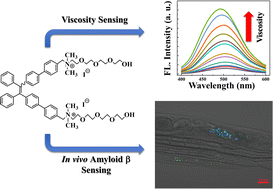A bifunctional TPE-based fluorescent sensor for liquid viscosity and amyloid β measurements†
Abstract
A bifunctional TPE-based fluorescent sensor (TPE-Q) for both liquid viscosity and amyloid β (Aβ) has been synthesized straightforwardly by the introduction of an ethylene glycol chain and quaternary ammonium to the classical tetraphenyl ethylene core. Due to the rotation of the intramolecular restriction (RIR) effect of TPE-Q, the sensor displayed liquid viscosity sensing capability with a promising linear relationship within 37 to 609 cp. The fluorescence enhancement was around 11.77 folds. On the other hand, TPE-Q showed both in vitro and in vivo Aβ sensing capabilities. By mixing with Aβ1−42 solution, TPE-Q showed a maximum fluorescence enhancement of 21.60 folds, with a detection limit of 160 nM. In addition, fluorescence colocalization experiments revealed a good merging of TPE-Q and commercial Th T, proving the in vivo imaging capability of TPE-Q in Aβ1−42 over-expressing Caenorhabditis elegans (C. elegans, CL4176). Furthermore, computational docking prediction revealed the binding pattern of TPE-Q towards Aβ aggregates.



 Please wait while we load your content...
Please wait while we load your content...